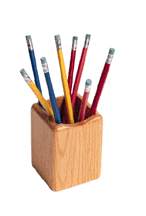An opinionated, humorous commentary and style guide, which begins with:
"Be skeptical of stylebooks. . . .
understand the reasons behind the rules --
and therefore know when they should be ignored."
|
The second half of his book is his "Curmudgeon's Stylebook",
which begins with teaching the reader how to determine which indefinite article to use:
the A or the AN. [His guideline means trouble for
non-native speaker: use the pronunciation rule not the spelling rule.]
It ends with teaching the reader how to decide whether to use
YES, I DO or YES, I HAVE. [His guideline has
you use the auxiliary verb - unless (this clause must be the joy of grammarians,
allowing them to nest deeper and deeper into arcana) - in reply to certain questions
that were asked with particular stresses.]
 A lively and informative compact book, by an author that loves language like a chocoholic loves a truffle.
Constance Hale gives you the basic rules grammar rules, salted with her own viewpoint, such as
calling verbs "moody little suckers" and adverbs "promiscuous."
But the biggest blessing of this book is the richness of its samples of great,
often spectacularly fascinating, writing.
A lively and informative compact book, by an author that loves language like a chocoholic loves a truffle.
Constance Hale gives you the basic rules grammar rules, salted with her own viewpoint, such as
calling verbs "moody little suckers" and adverbs "promiscuous."
But the biggest blessing of this book is the richness of its samples of great,
often spectacularly fascinating, writing.
Hale relishes words and their organization like other people relish food, wine, and a close personal relationship.
She welcomes you to break the rules of grammar, as long as you know the rules, and know why you're breaking them.
The book has 3 main sections:
 Words.
Words.
 Sentences.
Sentences.
 Music.
Music.
Subtopics within those give
chapters that range from Interjection (in Words), through Phrases and Clauses (in Sentences),
to Rhythm (in Music).
For 16 such section, she gives you:
- "bones" (grammar lessons),
- "flesh (writing lessons),
- "true transgressions" (the real errors), and
- "carnal pleasures" (the joy and beauty that result from your selective application of the rules).
Lots of brilliant examples.
And remember Hale on euphemisms, which she says, "are for wimps."
 Best Books on how to Write Poetry.
Best Books on how to Write Poetry.
 How to Write Poetry: A Recipe.
How to Write Poetry: A Recipe.
 Index.
Index.
 How to Read Poetry.
How to Read Poetry.
 How to Listen Poetry.
How to Listen Poetry.
 Ghazal.
Ghazal.
 Haiku.
Haiku.
 Pantoum.
Pantoum.
 Sestina.
Sestina.
 Sonnet.
Sonnet.
 Villanelle.
Villanelle.

 Patricia T. O'Conner was an editor at the New York Times Book Review.
Her cheerful and clear instruction on grammar is concise and funny.
Chapters include the grammar books you may remember. Chapter titles include
"Your Truly: The Possessive and the Possessed"
and "Comma Sutra; The Joy of Punctuation."
Patricia T. O'Conner was an editor at the New York Times Book Review.
Her cheerful and clear instruction on grammar is concise and funny.
Chapters include the grammar books you may remember. Chapter titles include
"Your Truly: The Possessive and the Possessed"
and "Comma Sutra; The Joy of Punctuation."
 This is the famous book wherein
Anne Lamott shows you how to find your passion, your voice, your
first draft (no matter how feeble),
and your publication-ready manuscript.
This is the famous book wherein
Anne Lamott shows you how to find your passion, your voice, your
first draft (no matter how feeble),
and your publication-ready manuscript.
 A lively and informative compact book, by an author that loves language like a chocoholic loves a truffle.
Constance Hale gives you the basic rules grammar rules, salted with her own viewpoint, such as
calling verbs "moody little suckers" and adverbs "promiscuous."
But the biggest blessing of this book is the richness of its samples of great,
often spectacularly fascinating, writing.
A lively and informative compact book, by an author that loves language like a chocoholic loves a truffle.
Constance Hale gives you the basic rules grammar rules, salted with her own viewpoint, such as
calling verbs "moody little suckers" and adverbs "promiscuous."
But the biggest blessing of this book is the richness of its samples of great,
often spectacularly fascinating, writing.